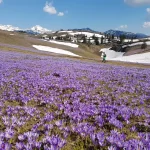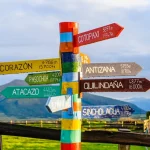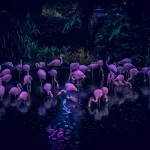
Discovering the Vibrant Culture and Natural Wonders of Jamaica: A Journey Through the Land of Reggae and Rastafarianism

Introduction to Jamaica: The Land of Reggae and Rastafarianism
Jamaica, the third-largest island in the Caribbean, is a vibrant and culturally rich country known for its reggae music, Rastafarianism, and stunning natural beauty. Located in the Greater Antilles, Jamaica has a fascinating history and a diverse population that has shaped its unique culture. From its colonial past to its independence, Jamaica has emerged as a nation with a strong identity and a rich cultural heritage.
Jamaica’s geography is as diverse as its culture. The island is characterized by lush mountains, pristine beaches, and cascading waterfalls. The Blue Mountains, located in the eastern part of the island, are famous for their coffee plantations and offer breathtaking views. The beaches of Negril, Montego Bay, and Ocho Rios attract tourists from around the world with their crystal-clear waters and white sandy shores. Inland, visitors can explore the Cockpit Country, a rugged and untouched region known for its unique geological formations.
Reggae music is synonymous with Jamaica and has become one of the country’s most famous exports. Originating in the 1960s, reggae music was popularized by legendary musicians such as Bob Marley, Peter Tosh, and Jimmy Cliff. The genre is characterized by its rhythmic beats, soulful melodies, and socially conscious lyrics. Reggae music has not only entertained millions but has also served as a platform for political and social commentary.
Rastafarianism is another significant aspect of Jamaican culture. This religious movement emerged in the 1930s and is deeply rooted in African spirituality and resistance against oppression. Rastafarians believe in the divinity of Emperor Haile Selassie I of Ethiopia, whom they consider to be the messiah. They also adhere to a strict code of conduct that includes vegetarianism, the use of natural herbs, and the rejection of materialism. Rastafarianism has had a profound influence on Jamaican culture, shaping everything from music to fashion.
The Vibrant Culture of Jamaica: A Melting Pot of Influences
Jamaica’s vibrant culture is a result of the diverse influences that have shaped the country over the centuries. The island’s history is marked by colonization, slavery, and immigration, all of which have contributed to the rich tapestry of Jamaican culture.
The indigenous Taino people were the first inhabitants of Jamaica before the arrival of Christopher Columbus in 1494. The Spanish colonized the island in the early 16th century but were eventually driven out by the British, who established a plantation economy based on African slave labor. The legacy of slavery is deeply ingrained in Jamaican culture, with African traditions and customs influencing everything from music to cuisine.
In addition to African influences, Jamaica has also been shaped by European, Asian, and Middle Eastern cultures. The British colonial period introduced elements of British culture, including the English language and the legal system. Indian indentured laborers were brought to Jamaica in the 19th century, contributing to the island’s multiculturalism and introducing Indian cuisine and traditions.
Religion plays a significant role in Jamaican culture, with Christianity being the dominant faith. However, there are also significant populations of Hindus, Muslims, and Rastafarians. The syncretic nature of Jamaican religion is evident in practices such as Pocomania, a blend of Christianity and African spirituality.
Jamaican customs and traditions are also influenced by its African heritage. One example is the tradition of “Nine Night,” a celebration held after someone’s death that involves singing, dancing, and storytelling. Another example is “Jonkanoo,” a traditional masquerade festival that takes place during Christmas and New Year’s.
Exploring the Natural Wonders of Jamaica: From Beaches to Mountains
Jamaica’s diverse landscape offers a wide range of natural wonders for visitors to explore. From its stunning beaches to its majestic mountains, the island is a paradise for nature lovers.
Jamaica is renowned for its beautiful beaches, which attract tourists from around the world. Negril’s Seven Mile Beach is one of the most famous, with its powdery white sand and crystal-clear waters. Montego Bay’s Doctor’s Cave Beach is another popular destination, known for its calm waters and vibrant marine life. Ocho Rios offers a variety of beaches, including the iconic Dunn’s River Falls, where visitors can climb the cascading waterfalls.
Inland, Jamaica is home to breathtaking mountains and lush rainforests. The Blue Mountains, located in the eastern part of the island, are a UNESCO World Heritage Site and offer stunning views of the surrounding countryside. The region is also famous for its coffee plantations, where visitors can learn about the coffee-making process and sample some of the world’s finest coffee.
Jamaica is also known for its waterfalls, which are scattered throughout the island. Dunn’s River Falls in Ocho Rios is one of the most popular, allowing visitors to climb up the cascading waterfalls and swim in the natural pools. YS Falls in St. Elizabeth is another must-visit destination, with its seven-tiered waterfall and lush surroundings.
For those seeking adventure, Jamaica offers a range of outdoor activities such as hiking, zip-lining, and river rafting. The Rio Grande in Portland is a popular spot for river rafting, where visitors can navigate the rapids while enjoying the scenic beauty of the surrounding rainforest.
The Rastafarian Movement: Understanding the Roots of Jamaican Culture
The Rastafarian movement is an integral part of Jamaican culture and has had a profound influence on the country’s music, fashion, and spirituality. Originating in the 1930s, the movement emerged as a response to the social and economic conditions faced by black Jamaicans.
Rastafarians believe in the divinity of Emperor Haile Selassie I of Ethiopia, whom they consider to be the messiah. They believe that he will lead them back to Africa, their ancestral homeland. Rastafarians also reject the oppressive systems of Babylon, which they see as a symbol of Western imperialism and capitalism.
The movement’s roots can be traced back to Marcus Garvey, a Jamaican political leader and activist who advocated for black pride and self-determination. Garvey’s teachings inspired a generation of Jamaicans to embrace their African heritage and resist colonial oppression.
Rastafarianism is characterized by its distinctive dreadlocks, which symbolize the movement’s rejection of Western beauty standards and its embrace of natural African aesthetics. Rastafarians also adhere to a strict code of conduct that includes vegetarianism, the use of natural herbs, and the rejection of materialism.
Reggae music has played a crucial role in spreading the message of Rastafarianism to a global audience. Legendary musicians such as Bob Marley, Peter Tosh, and Jimmy Cliff have used their music to promote social justice, equality, and spiritual enlightenment. Reggae lyrics often contain references to Rastafarian beliefs and teachings, making it a powerful tool for spreading the movement’s message.
Jamaican Cuisine: A Fusion of Flavors and Spices
Jamaican cuisine is a fusion of flavors and spices that reflects the island’s multicultural heritage. Influenced by African, Indian, European, and Chinese cuisines, Jamaican food is known for its bold flavors and unique combinations.
One of the most iconic dishes in Jamaican cuisine is jerk chicken or pork. Jerk seasoning is made from a blend of spices such as allspice, thyme, scotch bonnet peppers, and garlic. The meat is marinated in the seasoning and then grilled over an open flame, resulting in a smoky and spicy flavor.
Another popular dish is ackee and saltfish, which is considered the national dish of Jamaica. Ackee is a fruit that is cooked with salted codfish, onions, tomatoes, and spices. It is often served with fried dumplings or boiled green bananas.
Curry goat is another Jamaican favorite, influenced by the country’s Indian heritage. The meat is marinated in a blend of spices such as curry powder, turmeric, and cumin, and then slow-cooked until tender. It is typically served with rice and peas, which are cooked with coconut milk and kidney beans.
Jamaica is also known for its seafood dishes, thanks to its abundant coastline. Escovitch fish is a popular choice, where fried fish is topped with a tangy sauce made from vinegar, onions, carrots, and scotch bonnet peppers. Steamed fish is another delicious option, where the fish is cooked with tomatoes, onions, thyme, and scotch bonnet peppers.
To accompany their meals, Jamaicans enjoy a variety of beverages such as sorrel, a sweet and tangy drink made from hibiscus flowers; ginger beer, a spicy and refreshing soda; and rum punch, a tropical cocktail made from rum and fruit juices.
The Music Scene in Jamaica: From Bob Marley to Contemporary Artists
Jamaica’s music scene has had a significant impact on global music culture. From the birth of reggae to the rise of dancehall and the influence of contemporary artists, Jamaican music continues to captivate audiences around the world.
Reggae music emerged in the 1960s as a fusion of ska and rocksteady. It was popularized by legendary musicians such as Bob Marley, Peter Tosh, and Jimmy Cliff, who used their music to spread messages of social justice and spiritual enlightenment. Reggae’s infectious rhythms, soulful melodies, and socially conscious lyrics resonated with audiences worldwide and helped put Jamaica on the map as a musical powerhouse.
Bob Marley is undoubtedly the most famous Jamaican musician and is often referred to as the “King of Reggae.” His iconic songs such as “One Love,” “No Woman, No Cry,” and “Redemption Song” have become anthems of peace, love, and unity. Marley’s music transcends genres and generations, and his legacy continues to inspire artists around the world.
In addition to reggae, Jamaica is also known for its dancehall music. Dancehall originated in the late 1970s and is characterized by its fast-paced beats, catchy melodies, and explicit lyrics. Artists such as Shabba Ranks, Beenie Man, and Vybz Kartel have achieved international success with their dancehall hits.
Contemporary Jamaican artists continue to push boundaries and experiment with different genres. Protoje and Chronixx are leading the reggae revival movement, infusing traditional reggae with elements of hip-hop, R&B, and soul. Koffee, a young female artist, has gained international acclaim for her unique blend of reggae and dancehall.
Jamaica’s music scene is not limited to reggae and dancehall. The country has also produced talented artists in genres such as ska, rocksteady, gospel, jazz, and calypso. The diversity of Jamaican music reflects the country’s rich cultural heritage and its ability to adapt and evolve over time.
The Art and Craft of Jamaica: A Reflection of its Rich Culture
Jamaican art and craft traditions are a reflection of the country’s rich cultural heritage. From pottery to woodcarving, Jamaican artisans have created unique and beautiful works of art that celebrate the island’s history and traditions.
Pottery has a long history in Jamaica and is considered one of the oldest art forms on the island. The Arawak people, the indigenous inhabitants of Jamaica, were skilled potters and created intricate vessels for everyday use. Today, Jamaican pottery is known for its vibrant colors and intricate designs. The town of Port Royal is famous for its pottery studios, where visitors can watch artisans at work and purchase one-of-a-kind pieces.
Woodcarving is another popular form of art in Jamaica. The island’s lush forests provide an abundance of raw materials, and Jamaican artisans have honed their skills in carving intricate sculptures and masks. The town of Ocho Rios is known for its woodcarving studios, where visitors can witness the creative process and purchase unique pieces.
Jamaica’s vibrant culture is also reflected in its visual arts. The National Gallery of Jamaica in Kingston showcases the work of local artists, including paintings, sculptures, and mixed media installations. The gallery also hosts exhibitions and events that celebrate Jamaican art and culture.
In addition to traditional art forms, Jamaica has a thriving street art scene. Graffiti artists have transformed the walls of Kingston into vibrant canvases, using their art to express social and political commentary. The annual Kingston Creative Artwalk allows visitors to explore the city’s street art scene and meet local artists.
Sports in Jamaica: The Legacy of Usain Bolt and Beyond
Jamaica’s success in athletics has made it a force to be reckoned with on the global stage. The island has produced some of the world’s fastest sprinters, including the legendary Usain Bolt.
Usain Bolt is widely regarded as the greatest sprinter of all time. He holds multiple world records in the 100 meters, 200 meters, and 4×100 meters relay. Bolt’s electrifying speed, charismatic personality, and record-breaking performances have made him a global icon and a symbol of Jamaican excellence.
Jamaica’s success in athletics can be attributed to a combination of factors. The island’s warm climate and favorable training conditions provide athletes with an advantage. Additionally, Jamaica’s sporting infrastructure has improved significantly over the years, with the construction of world-class stadiums and training facilities.
Track and field is not the only sport in which Jamaicans excel. The country has also produced talented athletes in sports such as cricket, boxing, netball, and football. The Jamaican national football team, known as the “Reggae Boyz,” has achieved success on the international stage and has qualified for the FIFA World Cup.
Sports play a significant role in Jamaican culture and are seen as a means of empowerment and social mobility. Many young Jamaicans aspire to become professional athletes, hoping to follow in the footsteps of their sporting heroes. The success of athletes like Usain Bolt has inspired a new generation of Jamaican athletes to dream big and strive for greatness.
Festivals and Celebrations in Jamaica: A Colorful Calendar of Events
Jamaica is known for its vibrant festivals and celebrations, which showcase the country’s rich cultural heritage and provide an opportunity for locals and visitors alike to come together and celebrate.
One of the most famous festivals in Jamaica is Carnival, a colorful celebration of music, dance, and masquerade. Carnival takes place in Kingston and Montego Bay and features elaborate costumes, lively parades, and energetic street parties. The festival typically occurs in the weeks leading up to Easter and is a time for locals and tourists alike to come together and revel in the vibrant culture of Jamaica. The streets are filled with the infectious rhythms of reggae, dancehall, and soca music, as participants dance and move to the beat. The costumes worn during Carnival are a sight to behold, with feathers, sequins, and vibrant colors adorning the revelers. The parades showcase the creativity and artistry of the participants, with each group or band putting on a unique display. As the sun sets, the festivities continue into the night with street parties that last until dawn. Carnival in Jamaica is a true celebration of life, unity, and the rich heritage of the island.
If you’re planning a trip to Jamaica, you might also be interested in exploring the wonders of Sweden. From its stunning landscapes to its rich history and culture, Sweden offers a unique travel experience. Whether you’re visiting Stockholm’s beautiful archipelago or exploring the charming streets of Gothenburg, there’s something for everyone in this Scandinavian gem. Check out this article on Destination Mate for more information: Exploring the Wonders of Sweden.
Recent Posts


Exploring the Wonders of South America: A Journey Through the Continent’s Diverse Landscapes and Cultures
